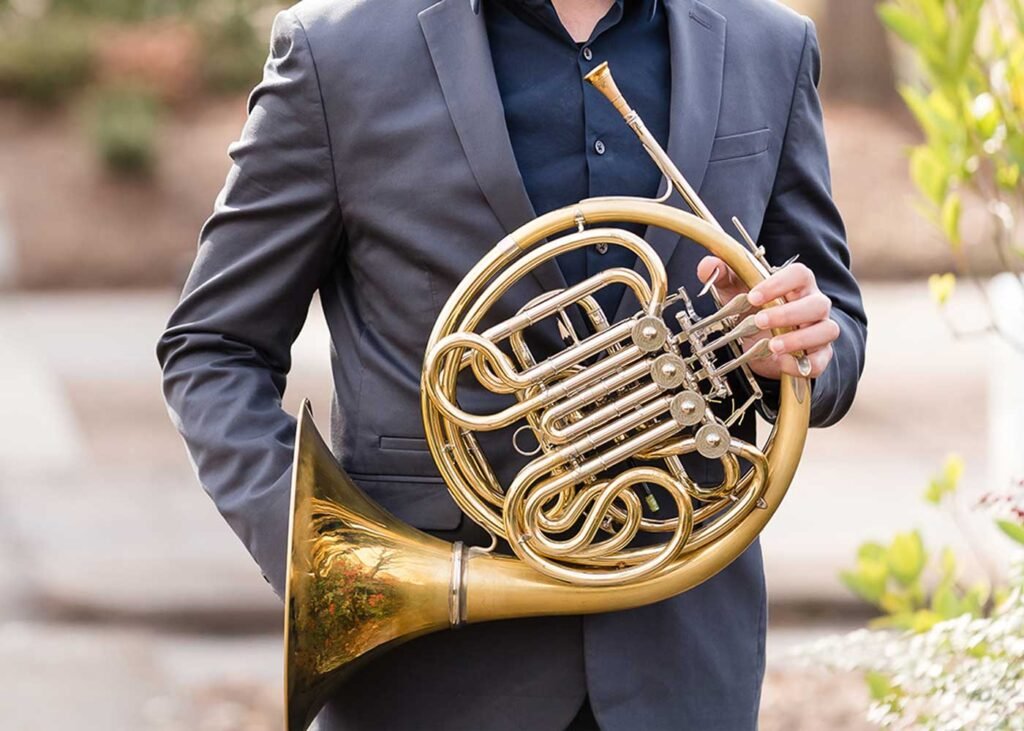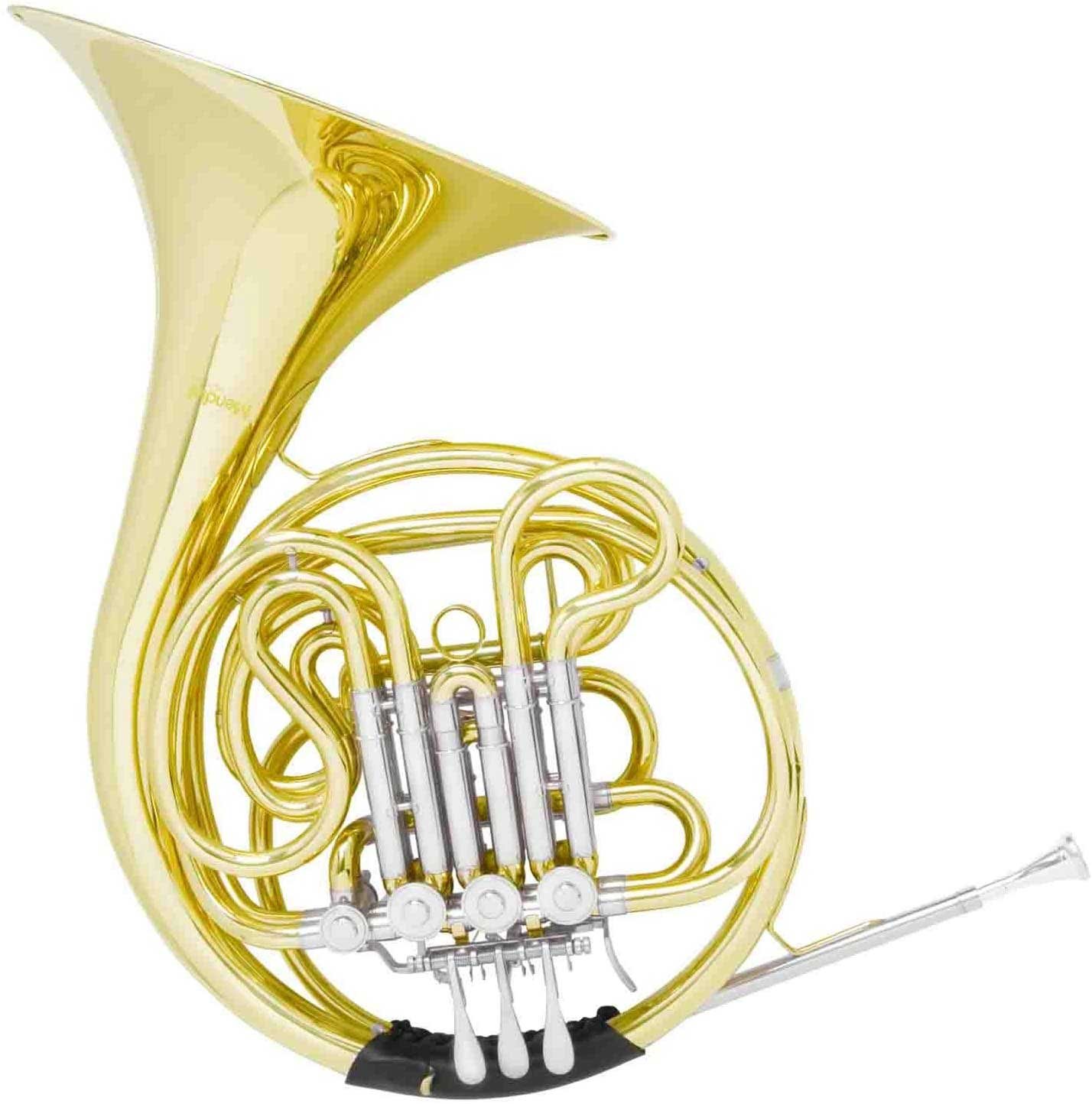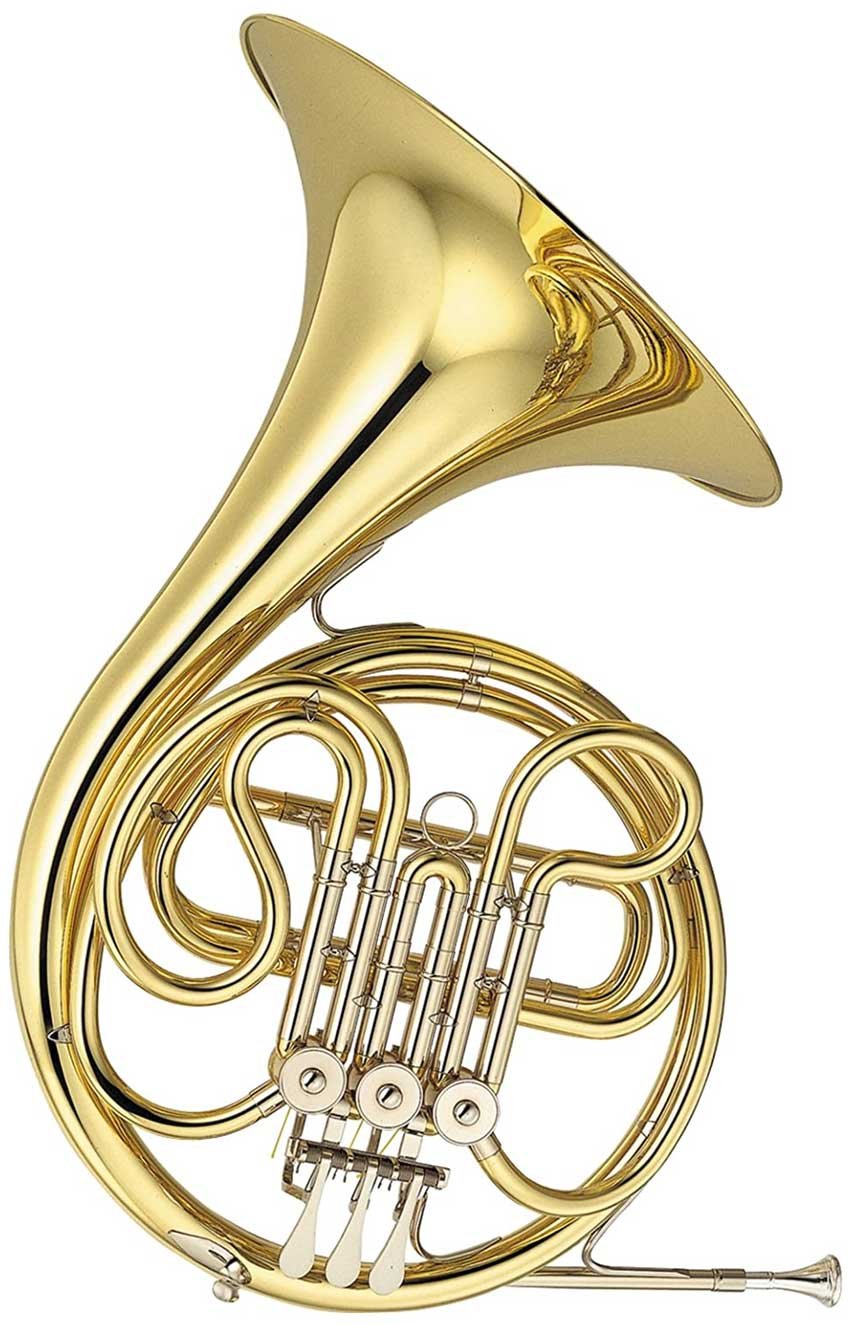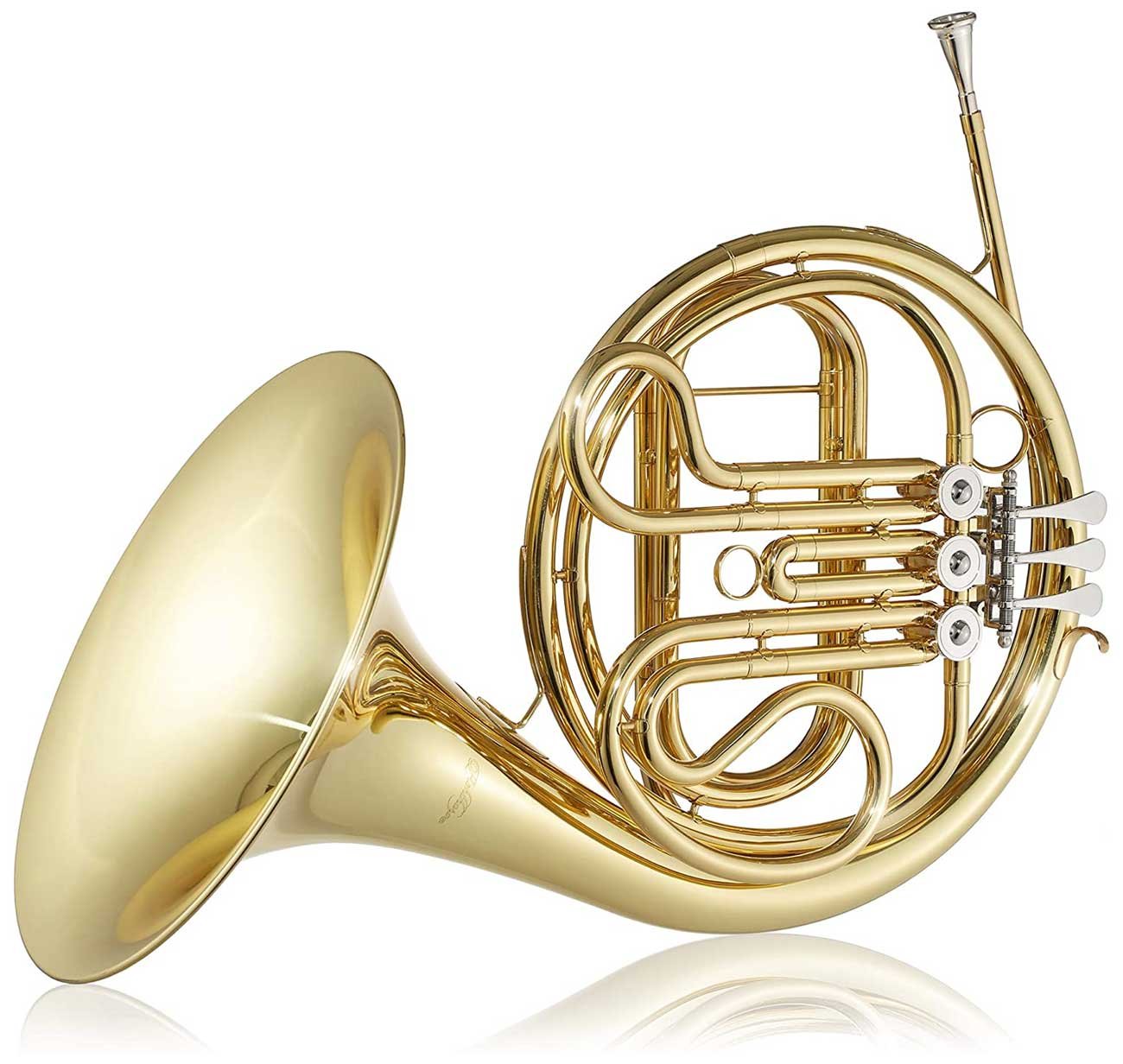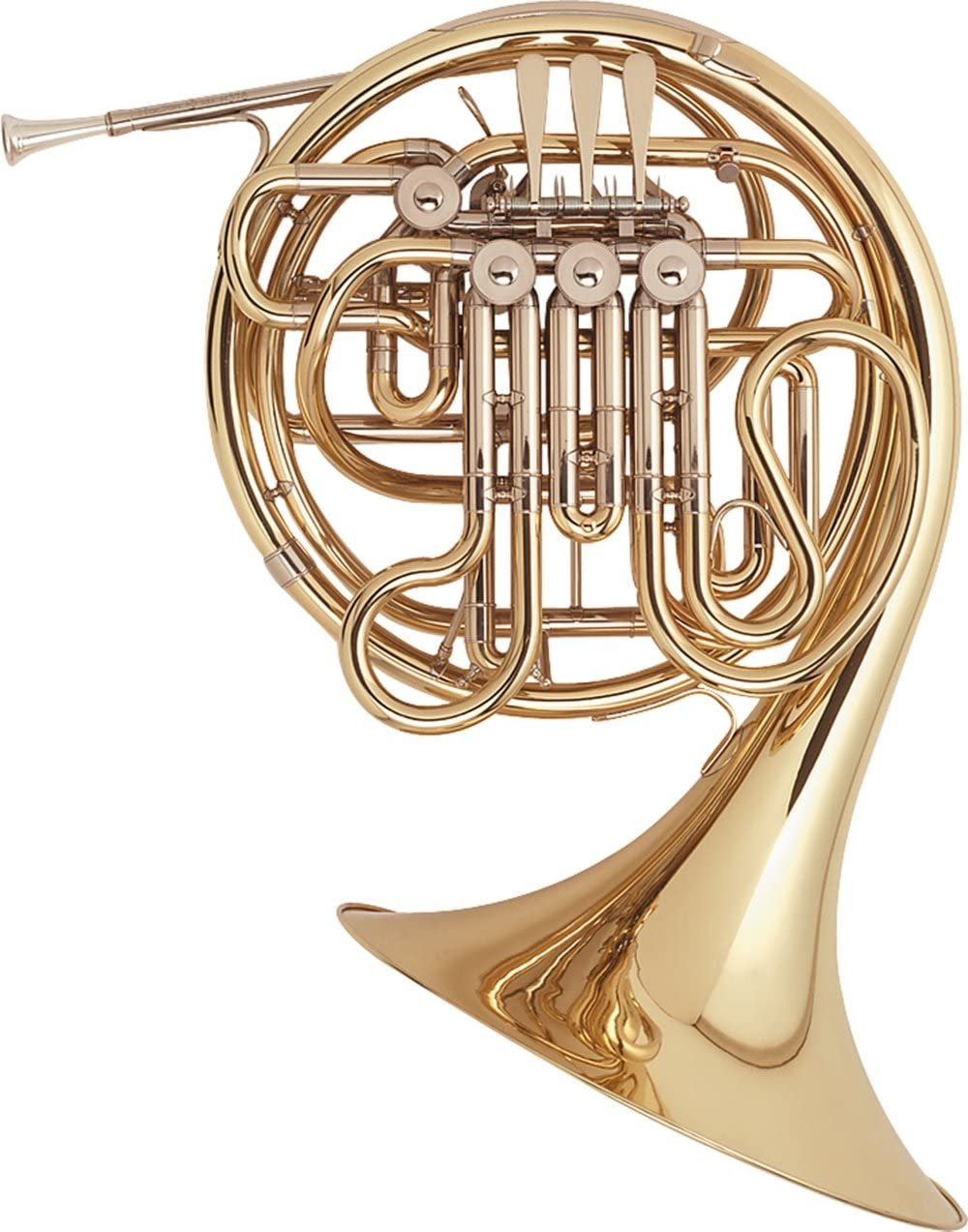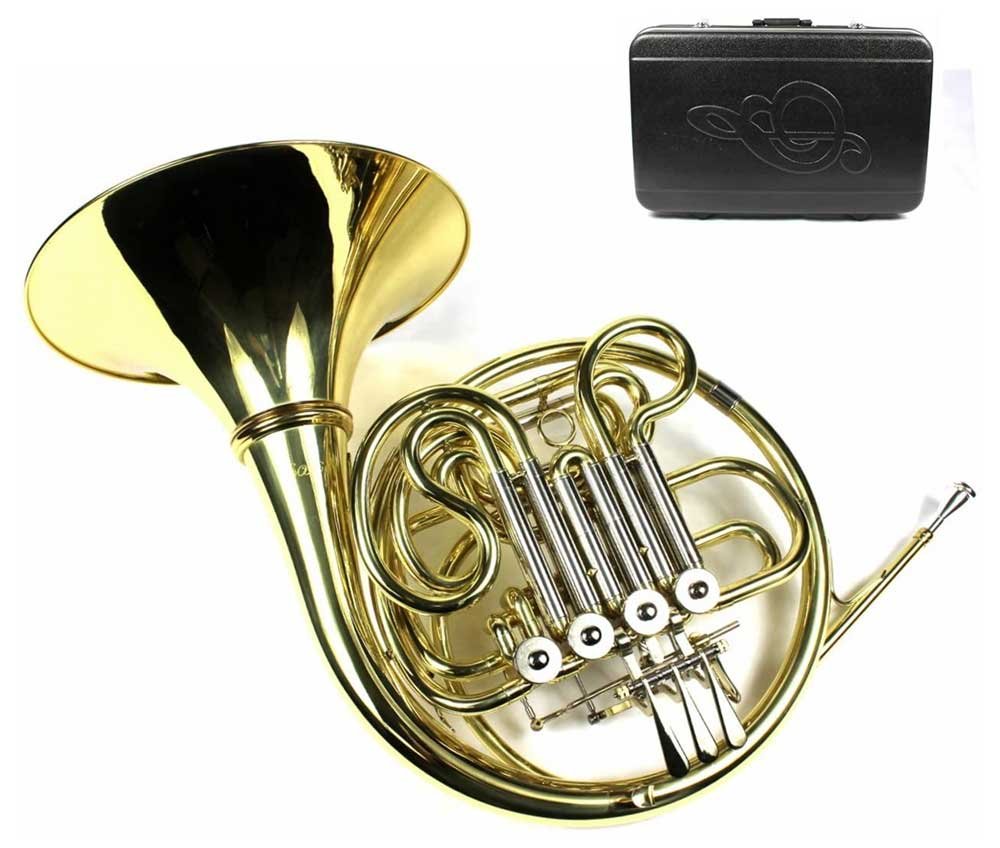The best French horn is a popular instrument for a wide variety of music, particularly symphonic ensembles and orchestras. It is greatly preferred for its calm, somewhat less aggressive sound, and it stands out with a large voice when performed with other instruments.
Choosing the best French horn can be a confusing experience if you don’t have the appropriate information, especially with so many options on the market.
We compiled a streamlined list based on the highest French horn reviews of some of the top-rated French horns available for purchase. We have included a buying guide to discuss all the important factors you need to consider while buying a French horn. In the end, we have also answered some of the most asked questions regarding French horns.
Let’s dive in!
Best French Horns Reviewed: Our Top 8 Picks
Unlike its English rival, the French horn is unquestionably French, with origins reaching back to the 1600s. It is a horn that can produce sounds ranging from delicate and soothing to loud and smooth. The eighteen-foot tubes are wrapped into a circle and topped with a big bell.
A French Horn can accompany two to eight horns playing rhythm, harmony, and melody in an orchestra. The musician must hold the instrument at the bell and blow it into the mouthpiece.
Here are our top recommendations for the best French horn on Amazon right now.
Mendini Intermediate Key of F/Bb Double French Horn
Mendini is one of the best French horn brands. This French horn is an F/Bb Intermediate Double French horn in a standard key.
It has a lacquered yellow brass body and bell, a.468″ bore 12″ bell, four solid rotors with string lever movement, and four solid rotors with string lever action.
This French horn comes with a Cecilio 92-D chromatic/string tuner with metronome, a silver-plated mouthpiece, a pro-deluxe protective case, a polishing cloth, and a pair of gloves.
Clarinets from Mendini by Cecilio are ideal for beginning French horn players.
This set of French horns comes with a one-year warranty. Each instrument is tested at Cecilio’s overseas manufacture before being tested again in their Southern California warehouse.
Pros
- Comes in a padded case with shock absorbing cushioning
- Lightweight horn and casing for carrying instrument easier
- Comes with the high quality necessary accessories
- Smooth movements of the valves to play warm tones
- An excellent choice for the beginners for centered tone
Cons
- Flimsy strings
Yamaha YHR 314II Student F French Horn
One of the best French horns for high school students is the Yamaha YHR 314II Student F French Horn. Yamaha instruments are one of the finest French horn brands and in the music industry as well.
Yamaha extends its own creative ability to create this masterpiece with the player in mind: a tapered design mouthpiece, open wrap for holding, and smooth airflow contribute to the player’s comfort.
This Yamaha French horn is lighter and less difficult than double horns, making it perfect for beginner French horn players.
This French horn’s mouthpipe taper is designed for improved responsiveness and intonation wrap. It enables simple hand positioning.
The strong nickel silver lining on inner and outer slides tapered valves produces deep tones. Internal and exterior nickel silver finishing makes a better fit and less corrosion than brass slides.
These horns are packaged in a lightweight ABS casing. However, they are on the pricey side.
Pros
- Outstanding intonation and good projection, single F key
- The design’s comfort is very well thought out, smooth airflow for smooth playing experience, minimal airflow resistance
- An excellent choice for beginning French horn players for centered tone
- Strong inner and outer nickel silver linings, great French horn
- Tonal quality is rich and warm tones
Cons
- A bit expensive, no hand-hammered exterior
Holton H179 Farkas Series Fixed Bell Double Horn
In terms of specifications, the H179 French horn has a .468-inch bell with a 12.25-inch diameter. It is also designed to pitch A445 and features F/Bb keys. For the artist, the Holton is recognized for its deep and rich sounding notes. It is better suited for a serious player who has progressed from a hobbyist.
The smooth, mellow tones produced by the flared bell have a ringing sound. The model also supports a screw-type bell. The hard nickel also adds to the instrument’s aesthetic value. It’s no surprise that this H179 is popular with academics and professionals. The full horn instrument weighs 21.3 pounds, and its dimensions are 28″ x 18″ x 17″.
Any passionate French horn player will well appreciate this instrument; it emits full sound and rich tones that will not go unnoticed in an orchestra. Even if you’re a soloist, the glossy tones it generates will be appreciated.
The secret is the hard silver nickel, which produces bright tones, punchier tones, and the larger bell. The academic or professional player will be delighted to notice how smoothly the tones fly out of the instrument.
Pros
- Fast shipping, amazing value than other instruments
- Amazing sound quality horns, best pitch accuracy, and clarity
- High durability, fixed bell, rich tone
- Handles mid, high, and low register ranges well
- Perfect weight for a double horn
Cons
- Not recommended for professional French horn players
Mendini MFH-20 Single Key of F Brass French Horn
This Mendini French Horn has an F single key, a .450 inch bore that is 12 inches in diameter, and three solid rotors that are mechanically joined together. This set also includes a silver-plated mouthpiece, gloves, and a cleaning cloth to guarantee that the French horn produces wonderful sounding tones.
The lacquered brass bell and body of these French horns provide a gorgeous, long-lasting appearance. The manufacturer also provides a one-year guarantee on the instrument. This is an excellent choice for a French Horn that can be carried on tour or for group performances because it comes with a customized wooden carrying case.
The metronome string tuner that comes with this Mendini wind instrument is an added treat. The Mendini MFH-20 has dimensions of 27″ x 19″ x 15″ and weighs 13.3 lbs. This French horn has a reasonable price point.
Pros
- Affordable price, great French horn, can make your own specially designed deluxe carrying case
- Amazing horn playing sound tunes, quality budget instruments
- Produces bold sound with strong projection and volume, comes with a wind instrument
- Packages include all the necessary accessories needed for a beginner French horn player and marching band
- Strong construction with a high quality finish and shiny appearance
Cons
- Does not include a water valve
8D CONNstellation by Conn
This French horn has a bore of .468 inches and a key of F/fb. The bell of this Conn French Horn measures 12.25 inches. The bells of these horns are fixed. The bell throat is quite huge; the size of the large bell throat measures 12.25 inches in diameter.
The warranty terms may differ depending on the manufacturer. It’s no wonder that this French horn model is popular among professional players; the nickel silver finishing gives it a distinct appearance.
If you’re concerned about the sound this French horn makes, it has dark, powerful notes that you won’t be able to overlook when performing in a group or as a solo act.
This nickel silver horn is 29″ x 18″ x 21″ and weighs only 13 lbs.
Pros
- Amazing sound quality with professional features
- Designed for both students and professionals
- Very responsive nickel silver horns, quality equipment
- Gives excellent control and accurate intonation, and excellent projection
- Comfortable weight for beginner or intermediate players
Cons
- A bit expensive paying required, no finger hook
Ashthorpe Single F French Horn
When it comes to value for money, this French horn is unparalleled. Because of its incredible qualities, it generates wonderful sound.
Ashthorpe Single F French horn is an excellent choice for both beginners and intermediate musicians. The horn features gorgeous and strong brass construction with a quality finish that will last you a lifetime and look new for a long time.
The gleaming gold lacquered finishing of these horns makes it an unstoppable heartthrob. The horn is far lighter and easier to play with than a conventional double horn. It has three tapered rotary valves that make key action a breeze. They also improve the responsiveness of the horn.
Furthermore, the French horn’s .450 bore and 12-inch bell size provide the excellent sound projection. It also comes with a slew of extras, including a polishing cloth, piston oil, white gloves, and a quality case for storing and transporting it.
Pros
- Brilliant sound quality
- High quality and durable tapered tubing
- Perfect match for both students and professionals
- Inexpensive, budget horn
- Great single French horn for the intermediate player and intermediate students
- Beautiful design, tapered rotary valves versatile
Cons
- No complaints were found against this French horn
Holton H378 Intermediate Double French Horn Key of F/Bb
Holton is one of the popular French horn brands, and their Holton H378 is the best intermediate French horn. It allows you to project over the ensemble with intonation that single French horns lack.
It will help you improve your proficiency with two horns, four valves playing. It’s a reasonably priced intermediate option.
It is an F/Bb standard key with Intermediate Double French horns. This instrument has a lacquered yellow brass body and bell, a twelve-inch bell, 0.468-inch bore, and 4 solid rotors with string lever movement.
Silver plated mouthpiece, pro-deluxe hard case, polishing cloth, and a pair of gloves are included.
The Holton H378Double French Horn comes with a manufacturer’s defect warranty, for which you need to contact the seller directly.
Pros
- A double horn offers progression to professional French horns playing
- Great French horn as the first instrument
- Precise intonation throughout the range, comfortable playing experience
- High quality accessories are included
- Superior sound quality and projection, free blowing
Cons
- Not suitable for professional players, only for intermediate players
Monel Rotors Bb/F 4 Keys Double French Horn
Moz instruments are known for providing musicians with more bang for their buck. Their expert band masters double-check each instrument before it is shipped out. At a reasonable price, the company provides each customer with a high-quality instrument they can afford. You’ll get your money’s worth out of this Double French horn!
The Monel Rotors Bb/F Double French Horn is an excellent choice for students. Rich and warm tone, an easy-to-play weight balance and smooth rotary response are all hallmarks of this instrument. The Monel Rotors Double French horn’s workmanship and concert-level sound will be a delight to your ears.
You can see this instrument has been meticulously finished in gold lacquer. Unlacquered instruments can make your hands stained if not handled with care, as do unlacquered horns. Lacquer can avoid this, but others claim that it “dampens” the tone. But for the majority of student instruments, lacquer is a suitable option because it provides additional protection and requires less maintenance.
It is a double French horn. F tubing is 12 feet long, and ‘Bb’ tubing is 9 feet long; all valves have separate slides for F and Bb (which can all be removed) for intermediate or professional models. In essence, it’s two separate horns that have been squeezed into one with a common lead pipe and bell. The Double Bb/F French Horn is the most popular type of horn and is utilized by the majority of musicians because of its wide variety of possibilities.
The pitch is influenced by the diameter of the bore. To achieve the best results, the horn’s cylindrical tubing (also known as the bore size) should be between.450 and.472 inches in diameter. The Monel Rotors French horn has a .469-inch bore.
The bell of this French horn is 12.244 inches in diameter and can be removed. This makes it possible to squeeze the horn into a more compact casing, making it simpler to transport. When it comes to children, these might be a little too much for them to handle because of their eagerness to assemble and dismantle them. In addition, the bell ring adds a small amount of weight, which can be difficult for some.
Pros
- Playing it is easy and comfortable
- Amazing clarity in the sound projection
- Suitable for beginner and intermediate horn players
- It’s one of the best Bb/F double horns on the market
- Easy maintenance
- A high-quality carrying case and mouthpiece are included with the instrument
- The ideal bore diameter
- Mechanical valves and four smooth rotors
- A well-balanced weight design
- The gold lacquered finish is stunning
- Exceptionally high level of craftsmanship
Cons
- Replacements parts are hard to find
- The valves and keys may be sticky
Types of French Horns
There are three primary forms of French horns: single horns, double horns, and triple horns. Single horns are the most common type. Additionally, a descant horn is a special form of triple horn that is explored in greater detail farther down this guide. Each one has its own set of specific qualities and applications.
These concerns and which types are most suited for players of varying ability levels, from beginners to pros, will be discussed in further detail below.
1. Single Horns
There are several different types of French horns available. The simplest (and least expensive) is the single French horn, controlled by three rotors and available in two keys: F and Bb. Single French horns are the desired choice for young students due to the lower cost, lighter weight, and ease of use that these instruments provide.
1.1. F Horns
It is the older model in the single horn category, and because of its lower tuning slide for tuning purposes, it has a classic, natural horn sound that is strong in the low and mid regions. The F horn is available in two sizes: standard and deluxe. It is the most popular choice for starting students in the United States because of its lightweight, relatively easy gameplay, and low cost.
For some performances, the usage of F horns is also acceptable for intermediate and professional musicians; nevertheless, they will often find them restrictive because they do not play very correctly in the higher ranges.
1.2. Bb Horns
Early solutions to the F horn’s limitations in the upper range included modifying the French horn to a higher tuning and playing it in the higher range. As a result, the Bb horn came into being. Some experienced French horn players choose the Bb horn for particular compositions because of its better response and accuracy in the high ranges and its modest body weight compared to other horns.
In terms of being a primary instrument, the Bb horn has some limitations. It has a less ideal tone in the low and mid-ranges and cannot play all of the notes in the low register, among other things.
2. Double Horns
The double horns were created to alleviate the problem given by single horns and to improve responsiveness across the range of the French horn. A double French horn is actually capable of moving between the keys of F and Bb by using a fourth rotor, thanks to the wizardry of tubular engineering. This rotor, which is activated by the left thumb lever, removes approximately 4 feet of tubing from the vibrating air column within the horn.
Some horns can also be modified so that the lever functions in the opposite direction, transforming the horn into an F instrument when engaged.
Double horns are particularly popular as a primary instrument for intermediate and professional performers due to their versatility. However, depending on the level of devotion to the instrument, their higher cost and added weight may make them a less-than-ideal choice for young pupils.
When selecting a French horn, one factor is the instrument’s wrap or how the tubing is coiled. A double horn can be wrapped in one of two ways. When the horn is in play, the Kruspe wrap elevates the fourth rotor over the other three. As a result, the linkage between the rotor lever that controls the fourth valve and the actual rotor is shorter.
The Geyer wrap (called after its German designer, like the Kruspe wrap) places the fourth rotor behind the third. The linkage is substantially longer since it extends past the other three rotors.
A single F horn is a typical model for beginning players. However, a double horn is more commonly made for intermediate and professional musicians. Both tiers have better construction and high-quality materials. Professional models frequently feature sophisticated craftsmanship for the best tone and expressiveness.
Although these models are more expensive than single French horns, some students may find that a quality double French horn is a better long-term investment that they can continue to use as their playing talents improve.
3. Triple Horns
While the double French horn effectively combines the F and Bb horns into one instrument, the triple horn adds another: the alto F horn. The triple horns are becoming an increasingly popular alternative, particularly among professional musicians, due to their improved response in the high registers.
Some may consider the instrument’s weight and higher price to be significant negatives. Browse the Musician’s Friend assortment of triple French horns for a horn that can handle any range with ease.
As a beginner, you may seek an instrument with more steadiness in the upper registers and less concern for the low and middle registers. In this situation, a descant horn—basically a double horn that combines the Bb and alto F horns—might be a decent choice. Descant horns, which are smaller in weight and less expensive than triple horns, are favored by certain players for performing music emphasizing the horn’s higher range.
Buying Guide for the Best French Horns
Purchasing a French horn is a substantial financial investment. The first step in buying the best French horns for you is determining your (realistic) budget for a new French horn. The double horns can cost anywhere from $200 to $18,000, so having a budget is essential for narrowing down your options.
Suppose you’re searching for a new double horn. In that case, we recommend setting a budget of at least $3,500 (more is better) because anything less than this is likely to be manufactured with poor quality control. The valves frequently do not fit, the slides fall out, the solder joints are badly done, and the French horn’s tapering parts are fouled up on these inexpensive horns. Repairing simply the valves on these horns can sometimes cost more than the horn itself.
There are numerous factors to consider before purchasing a French horn, but here are a few fundamentals.
Wrap
Kruspe and Geyer are the two most common French horn wraps. Kruspe wrap horns feature the change valve closer to the “front” of the French horn (closer to the player). In contrast, Geyer wrap French horns have the change valve on the “back” of the French horn (away from the player). While there are numerous opinions on the effects of this, here are a few general observations:
While not always the case, Kruspe wrap horns are often nickel silver in color, with larger bell throats that produce warmer sounds.
Geyer wrap horns are typically (but not always) made of yellow brass with medium-sized bell throats, producing a bright sound.
Material
Generally speaking, there are three types of materials used by horn makers to make French horns. Yellow brass, rose (or gold or red), brass, and nickel-silver are the most common metals and metal rods used for making most horns.
I. Yellow Brass
This is probably the most common material to produce French horns. It has a medium dark sound, yet it is capable of producing much brighter sounds when pushed. It is also right in the middle of the spectrum when it comes to hardness compared to most horns that use other materials.
II. Rose Brass
Rose brass is a softer material than yellow brass; it also makes the rose brass bell. Thus you should handle it with caution to avoid dings and dents. Compared to yellow brass, the tone is deeper, and there is less tonal flexibility available with this instrument.
III. Nickle Silver
In contrast to silver-plated trumpets, nickel silver French horns do not include any silver plating at all; instead, they are constructed entirely of a different alloy. It does not contain any silver, and the nickel content derives the color. Because it is an extremely durable material, it can be used to make high end instruments that are a little thinner than the standard. Nickel silver horns produce a fairly brilliant sound by nature, typically used in conjunction with wider bell throats.
Bell/Bore Size
When describing their instruments, several manufacturers would use words like “medium bore” and “medium bell” to describe their products. In the vast majority of instances, they are referring to the size of the bell neck.
In general, the bore (which is the cylindrical tubing of a brass instrument) is between 0.468 and 0.472 inches in diameter for all French horns, and the diameter of bells is usually approximately 12 inches in circumference. French horns with a big bell neck tend to produce warmer tones. In comparison, instruments with medium and small bell throats produce progressively brighter sounds and brighter punchier tones.
Fixed or Detachable Bell
This is primarily an issue of personal preference, convenience, and financial constraints. The addition of detachable bells or removable bells is a nice feature for people who travel a lot with their French horns (especially on airlines). Still, they can raise the price of a new instrument by several hundred dollars. The bell ring also adds a small amount of weight to the French horn, which can be difficult for some people to manage.
While there is probably certainly a difference in sound and playing between a fixed bell and a detachable bell, opinions on which is genuinely preferable are extremely divided.
Lacquered or Unlacquered
This is primarily an issue of personal preference, convenience, and financial constraints. The addition of detachable bells is a nice feature for people who travel a lot with their French horn (especially on airlines), but they can raise the price of a new instrument by several hundred dollars.
The bell ring also adds a small amount of weight to the French horn, which can be difficult for some people to manage. While there is probably certainly a difference in sound and playing between a fixed bell and a cut bell, opinions on which is genuinely preferable are extremely divided.
French Horns Maintenance Tips
- Use a mouthpiece brush, dish soap, and warm water to clean your mouthpiece.
- Using your polish cloth, thoroughly clean the finish of your French horn.
- Apply slide oil to the slides. Pull them out one at a time, clean them with a soft cloth, apply a small quantity of slide grease to them, and carefully replace them in your French horn. Illustration of a French Horn
- The rotors should be oiled. Remove the valve caps and work the oil into the bearing shaft and pivot points by moving the valves.
- Wash out the inner parts of your French horn every few months to maintain it clean and in good working order.
- In a big sink or bathtub filled with warm water and mild dish soap, disassemble your French horn (do not touch the rotor valves, which a specialist should disassemble) in a big bowl or bathtub filled with warm water and mild dish soap.
- Be extremely cautious when handling the dismantled parts, as even the slightest dent will prevent them from fitting back into your French horn and moving properly. Any falls will be cushioned by a soft towel on the counter and at the bottom of the sink or tub.
- Scrub the insides of the tubes gently with your cleaning snake.
- Thoroughly rinse and thoroughly dry the parts.
- Apply a small amount of lubricant to the slides before reinstalling them in your French horn.
Final Thoughts
Our list results from the highest French horn reviews and opinions from experts and renowned brands. We have struck a balance where the list features the best of both worlds! This people’s choice list reflects what the experts have deemed best features. We hope you meet the right French horn here.
If you have any queries, comments, suggestions, or exactly what feedback you have, you can write to us directly (data rights reserved by our privacy policy).
FAQs
How much does a French horn weigh?
Ans: A French horn can weigh between 25 and 30 pounds. It is dependent on the type. A professional horn will be much heavier than an ordinary or student horn. Regular and student horns weigh between 10 and 15 pounds.
How much does a good French horn cost?
Ans: Beginner or younger player French horns typically cost between $1,200 and $3,500. Intermediate or step-up French horns typically cost $3,500 to $4,500, with entry level pro French horns (which are still mostly used by advanced students and seasoned players) costing $4,500 and higher from the leading manufacturer and trusted brands.
Is a French Horn Easy to Play?
Ans: Because of its difficulty level, some people consider the French horn to be one of the most difficult instruments to play. Although the French horn can hit a wide range of notes, it is also quite easy for a player to crack notes or play them flat, making it much more astounding when mastered completely.
What are the differences between single, double, and triple French horns?
Ans: The single F horn is the longest and has the narrowest tonal color range of any French horn. A double horn is a musical instrument with two tubes of varying pitches. A double horn is often made up of an F tube and a Bb tube. All three pipes are included in a triple horn: F, Bb, and high-F tube.
What French horns do professionals play?
Ans: The double horn in F/Bb (officially a type of German horn) is the French horn most commonly used by professional orchestral and band players.
Who is the best French horn player in the world?
Ans: Hermann Baumann is regarded as the finest French horn player globally and a gifted composer and teacher. Baumann began his musical career by singing and playing jazz drums. However, when he was 17, he switched to the French horn. He began his musical career as a fellow of many orchestras before moving on to a solo career.
Why do French horn players put their hand in the bell?
Ans: The use of “hand stopping” and the positioning of the hand in the bell dates back to the eighteenth century. Because the early orchestral horns lacked valves, they could only play notes in the overtone series. A.J. Hampel (another German) created hand stopping to tackle the problem of range on the French horn. When French horn players used their hands to partially or completely close the bell, the pitch changed, allowing diatonic scales to be generated across a broader range.
French horn players may play chromatically across their whole range without stopping their hands because French horns have valves for the most accurate scales. However, some modern composers still request a stopped horn, an effect employed to create a nasally sound. Modern French horns are manufactured a quarter-tone sharp so that the pitch is adjusted when the hand is inserted into the bell.
Why is French horn the best?
Ans: The French horn is the brass instrument with the most tubing and the smallest mouthpiece, sometimes called Pocket French Horns. It blends in and is a staple in woodwind and brass quintets, and it has a distinct and magnificent sound. Even though it is the most difficult brass instrument to play, many Horn players think that it is well worth the effort.
